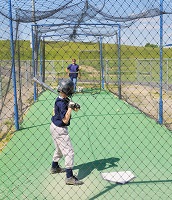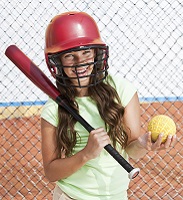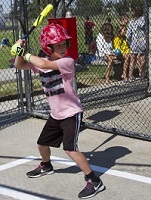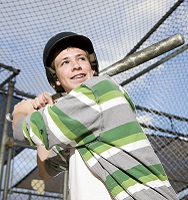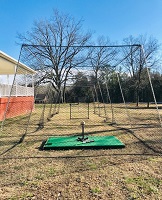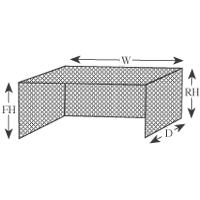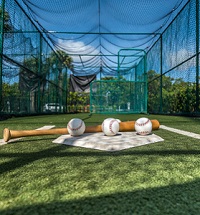
Batting Cages
Batting Cages Information
There are many things to consider when purchasing a batting cage. This article intends to help you work through these issues and make the best purchase for your needs and wants.
First, identify the reason you wish to purchase a batting cage. From youth development to professional practice, Memphis Net & Twine produces a net and framing options that will work for you. Second, you need to determine the physical location you intend to build your new batting cage. Our batting cages can be hand-built to exact specifications to fit any area, indoors or outdoors. Third, you should examine all our available options in netting thickness, cage length, design, and installation to find the batting cage that best meets all your needs. Fourth, there are several accessories that will work with your new batting cage and you should consider adding. A pitching machine and a batter's box are the usual starting place for people, but we also offer backstops, batting helmets, batting tees, and other useful items depending on your use. Fifth, you should gain a solid understanding of how to install your new batting cage and of the different options available to construct the frame, connect the net, and anchor the entire assembly. Finally, you should learn about the maintenance and care needed to extend the life of your new batting cage. Different netting types have different expected lifespans, based on expected use. At the end of this article, you should be able to evaluate the choices available and pick the best option for your needs and wants.
Who buys batting cages?
There are several groups of people that are likely to purchase batting cages. Here, we'll look at those groups of people to identify their needs and what will generally work for them.
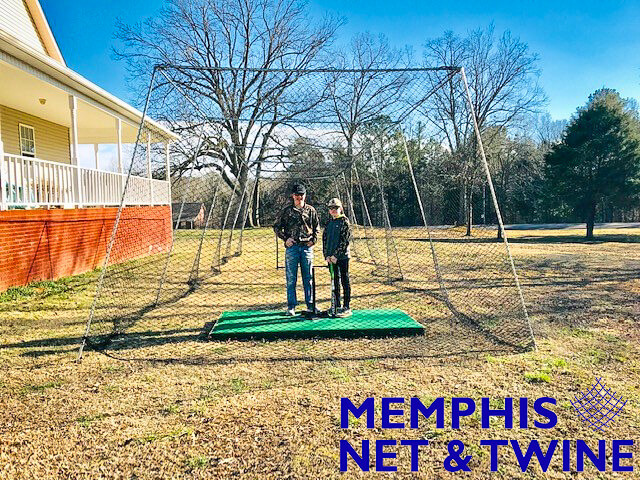
Parents will buy batting cages for their children of any age for training and development. Batting cages allow for efficient hitting drills and a dedicated space for practice. This can be effective from the beginnings of youth sports all the way through high school and college. Our Backyard Cages are a great choice here. Available in many sizes off the shelf and any custom size desired, our Backyard Cages are meant to fit in tight outdoor areas while still providing plenty of room inside for practice. Our Backyard Cages are also meant to be easy to construct and install. Two people working together should be able to assemble it in less than an hour. There are no holes to dig, no concrete to pour, and no special tools needed. Our design does require the customer purchase 18 to 38 ten-foot pieces of 3/4" electrical conduit from a local hardware store, depending on the size of the batting cage. This is to save a huge amount on the shipping cost
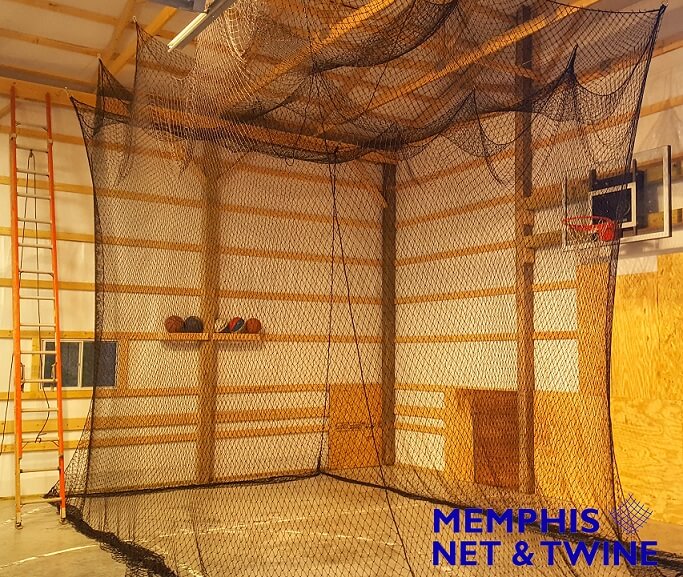
People will buy batting cages for themselves. Sometimes the best entertainment is hitting something really hard. That's where we can help. We offer all the items you need to create a major league quality batting cage at home. Once again, our Backyard Cages are a good fit. Also, we offer kits to hang cages indoors and can work with you to build a net exactly to your size specifications. Batting cages of this type can do double duty, if you use a net that can also work for golf balls. For the best results, contact us directly via phone or email to get a solution personally tailored to your available area and desired use.
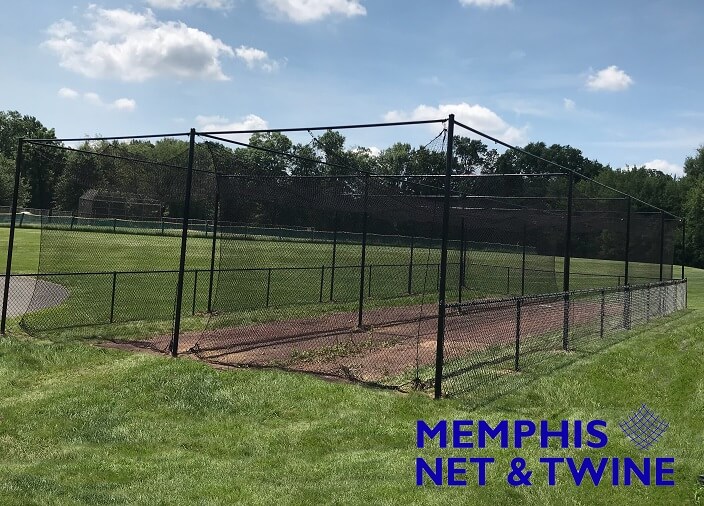
Teams are a large customer segment for batting cages. Teams can be AAU or school-based, amateur or professional, church or community, and everything in between. All baseball teams will benefit from a dedicated area for hitting drills and practice. Many teams that can dedicate space for their batting cages will tend to use our Standard Batting Cages with a net that is matched to their level of use. However, some teams must share space and we have a different set of solutions for these programs. We have multiple choices for indoor installation, when there is a gym or other athletic facility available to the team for practice. We offer free standing Indoor Batting Cage frames and kits to hang Indoor Batting Cages. The hanging kits allow for the net and cables to slide out of the way after practice, giving you a permanent solution that doesn't completely take over your indoor space. Our free-standing Indoor Batting Cage frames are the same as our Outdoor Batting Cage frames, but with rubber feet to stabilize sections and protect the floor. Meant to be semi-permanent, these batting cages can still be moved when necessary.
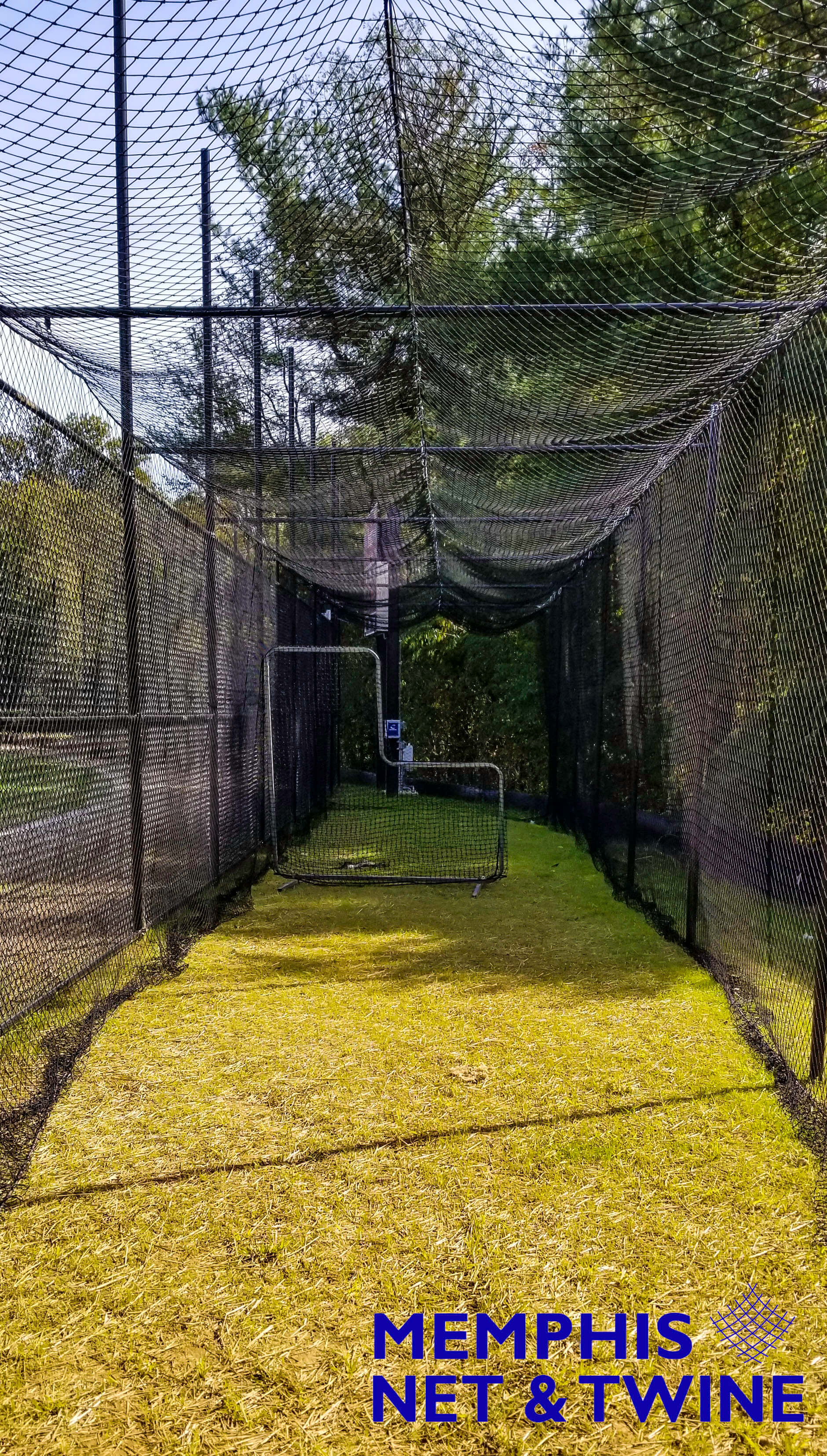
Finally, businesses will buy batting cages for a couple reasons. Some businesses, such as mini-golf courses, will buy them as an attraction. Batting Cages have always been popular in this context. For the business owner, they are a low-cost and low-risk way to add more profit-making activities to their venue. Some businesses buy batting cages as part of the infrastructure for athletic training services. In this case, the batting cages needed are largely determined by the available space and expected use. For businesses, often the best course of action is contact our team and look at custom options built exactly to your specifications.
TO DO BEFORE BUYING A BATTING CAGE
By nature, batting cages are large so the most important step before buying one is to determine the area where you wish to place it. The amount of space you have available will help you sort through the many options and designs available. Our Backyard Batting Cages are 10 feet tall, 13.5 ft wide, and 30 to 70 feet long. Our Movable Batting Cages can fit in a much more compact area being 14 feet tall, 14 feet long, and 18 feet deep. A rule of thumb to keep in mind is to leave two feet of clearance on all sides to allow room for the net to catch balls without contacting anything outside the batting cage. Our designs can all be customized to the space you have available. Indoor batting cages require more attention to detail in ordering phase to ensure the best match to your facility. We recommend contacting us with the measurements of your selected area and allowing us to present the best options based on our years of experience building and installing batting cages all over the country.
AVAILABLE OPTIONS FOR BATTING CAGES
There are many options available for your new batting cage. Examining these will help inform your purchase and make sure you get the batting cage you really want. We'll look at net size and frame options below.
The first and most obvious is the various sizes of netting you can order. Starting with a #23 twine, this is our smallest netting on offer. It is ideal for youth development and little league. It has 241 pounds of tensile strength and is expected to last three or more years. Our #30 twine is great for individual use and adolescent team use. It adds strength and durability from our #23 twine but is still an affordable option for most people. We recommend our #36 twine for high school installations. It is a good mix of value and long life and intended for heavy use. Our #42 twine is the largest size we sell off the shelf, though larger sizes are available in custom orders. This twine has tensile strength over 400 pounds and should last for six or more years. This is our first recommendation to college programs, but also works great for private athletic facilities and for-profit batting cages.
Second, what length of batting cage will work best for your application? Professional baseball sets the pitching mound at 60 feet and six inches from home plate. Our longest batting cage nets are 70 feet to cover this space. Even if not pitching from the full distance, the longer tunnel allows for better tracking on the flight of the ball. This is vital for coaching and development. Also, there is more room for extra equipment, such as pitching machines and ball carts. Smaller lengths of batting cages allow for better fits to the available space. In extremely space-limited situations, our Movable Batting Cage has the smallest footprint while still be useful.
If building your batting cage inside, the choice of using a frame versus hanging the net from the ceiling become important. Our kits to hang indoor batting cages allow the cage to slide out of the way, if necessary. Using a frame indoors is good for a single use area. Indoor baseball cage frames can be moved, but not easily. They are a good option for creating multiple cages in a single area devoted to batting cages. A hanging cage works better when there are multiple activity types in your area and the batting cage must be moved out of the way regularly.
AVAILABLE ACCESSORIES FOR BATTING CAGES
In addition, it is a good idea to determine the accessories you may want before ordering your batting cage. We offer many extras for added utility and safety.
Will you always have someone to pitch the ball or will you need a pitching machine or batting tee? Putting down a Batter Box mat or Home Plate mat will protect the ground from players digging in and provide a way for youth to see the safe areas to stand. A pitching machine gives you a consistent moving ball for players to build hand-eye coordination and swing technique. A batting tee is a stationary target but can still provide a big benefit to swing mechanics, with proper coaching.
We offer many safety options, as well. Batting helmets and face protectors are great for eliminating injury chances. We have multiple choices of hitting, pitching, and protector nets. If you'll be using a live pitcher, especially at a short distance, a pitching screen can keep them safe from hits returning down the center of the tunnel.
In a similar vein, we have several backstops that will work with our batting cages. These are great for protecting the one area behind the hitter that will take more ball impacts than anywhere else on the batting cage. While useful in any situation, they are vital if your area is tight and you haven't been able to leave two or more feet of free space behind the batting cage.
HOW TO INSTALL A BATTING CAGE
The biggest challenge of owning a batting cage is installing the batting cage. Here, we'll attempt to give you an overview of the process for the different designs we offer. Understanding the assembly and installation needed for the various types will help you choose the batting cage that will best fit your wants and needs.
Starting with our outdoor standard Batting Cage Frame, as it takes little assembly but does require some extra work during installation. This frame consists of horseshoe sections of 1-5/8" steep pipe installed approximately every ten to fifteen feet to hold the netting. The hooks and clips for the netting are already installed so you only must anchor the horseshoe sections into the ground. We include two 2' PVC sleeves for each horseshoe section. These are meant to be cemented in the ground to create a solid foundation to insert the legs of the horseshoe. Each horseshoe section weighs approximately 110 pounds, so we recommend having several people to help with installation. The more accurate your measurement and placement of PVC sleeves in concrete, the easier this batting cage is to assemble.
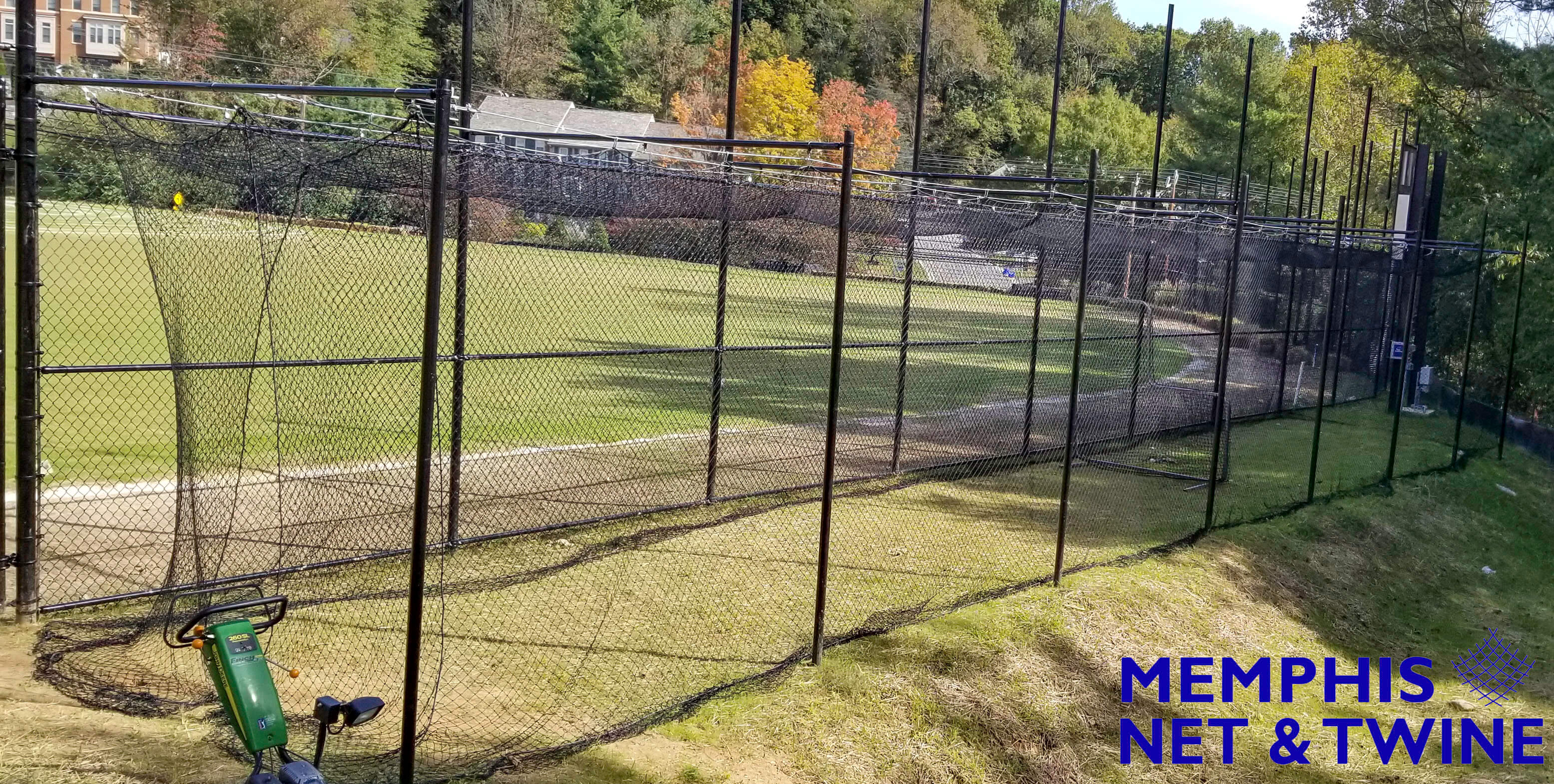
The Backyard Batting Cage is meant to provide a less permanent installation and allow for an easier assembly than our standard Batting Cage. You also save a substantial amount on shipping, because we only send the special fittings for the angles and corners of the frame. You can purchase the straight pieces of ¾" diameter steel conduit at a local hardware store. The amount needed is different for each length available, but ranges from 18 to 38 pieces. Each piece of conduit should be 10 feet long. Assembly of this frame is as simple as inserting the conduits into corner pieces we provide and tightening the attached bolts. The frame can be anchored to the ground as you see fit. Finish by clipping the net to the frame and your batting cage is complete. In most cases, installing a Backyard Batting Cage takes less than an hour from start to finish with two people.

The Free Standing Indoor Batting Cage has a very similar setup to the standard outdoor batting cage, minus laying PVC sleeves in concrete. Instead, the horseshoe sections have feet with heavy duty rubber pads to stabilize the sections and protect the floor. Each section comes with enclosed instructions for that particular section. Once the horseshoe sections are assembled, you move them into place and clip the netting to them. We recommend having four people available for this installation because the section pieces are large and heavy. No specialized tools are required, though.
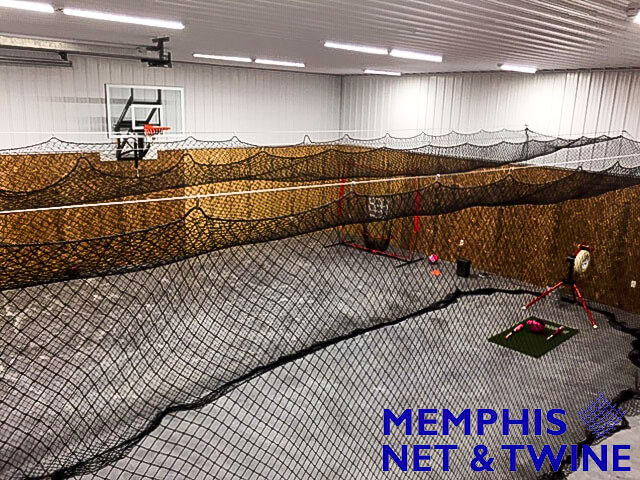
We have two frame-less options for hanging a batting cage net indoors. The main difference will be ceiling height and the ability to slide the net out of the way when not in use. Our Ceiling Kit is meant for gymnasiums or other areas with very high ceilings. We provide thirty 30' vertical cables to attach the netting to the ceiling, plus all associated hardware needed to connect it. Our Indoor Kit provides three 100' galvanized wire cables meant to be attached wall-to-wall. We include the hardware for mounting those cables and then for connecting the net to the cables. When this kit is installed, the net is free to slide all the way to one end of the other, getting it out of the way when needed.
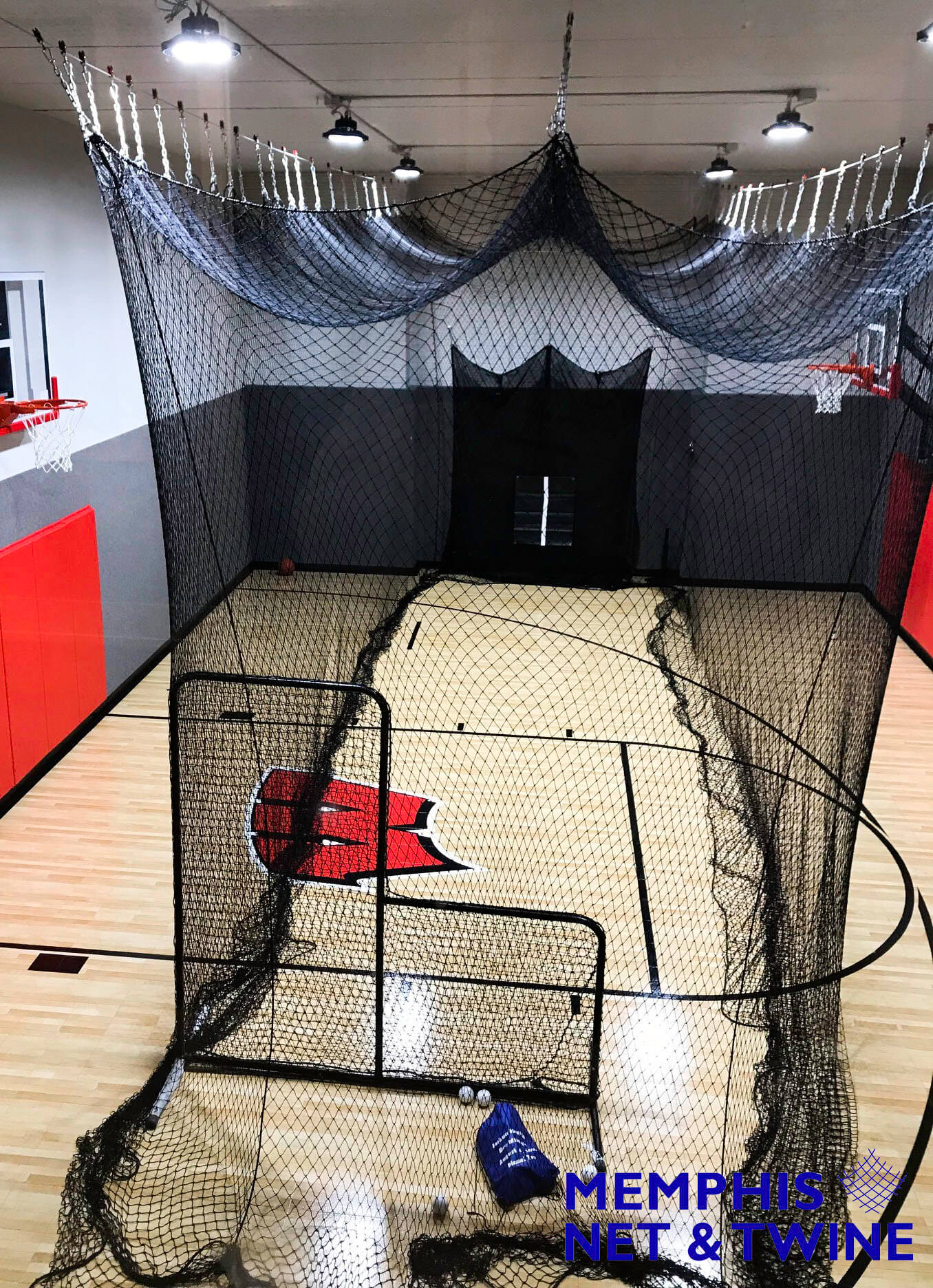
Here's an additional note for installing any net on any frame for the purposes of creating a batting cage. You should purchase an additional 1 to 2 feet of extra net on each side for best results. If the net is tight when mounted to the frame, baseballs will bounce off it and possibly lead to damage or injury. Having a more slack net allows the energy of a struck baseball to be completely dissipated in the loose netting. It has the benefit of naturally collecting balls in the folds of netting on the ground, also. All in all, it is safer and more convenient to have a looser net.
CARE AND MAINTENANCE OF BATTING CAGES
The three most important pieces of after-care and maintenance of your batting cage occur when you choose the netting during the purchase. You have several options on materials available and they make a huge difference to overall lifespan of your batting cage.
First, netting is generally available in Nylon or Poly. We recommend Nylon. In fact, we don't build batting cages nets from Poly except as part of a custom order. Nylon is designed to stretch, it has high abrasion resistance, and a longer lifespan than Poly. While being more affordable, we don't recommend Poly outside of light-duty home-use batting cages.
Picking the correct size of twine in your netting also makes a huge difference in the life of your batting cage. We offer #21, #30, #36, and #42 off the shelf. The smaller the number, the smaller the diameter of twine. Generally, we recommend #21 for light home use, #30 for Little League, #36 for high schools, and #42 for college. That said, the larger gauges will have longer lifespans with same amount of activity. In this case, we recommend purchasing the thickest netting that fits within your budget. If you aren't sure how your planned use stacks up, give us a call and let one of our experts help you make the decision.
Finally, you should consider how the netting is treated during construction. All baseball batting cage nets from Memphis Net & Twine are both dyed black and bonded. They are dyed black for high UV resistance. This is crucial for the lifespan of outdoor netting. It also makes the ball easier to follow against the backdrop of the cage. The bonding is a light treatment of a bonding agent to our twine that prevents unraveling and adds abrasion resistance. This is an important step for any net, indoor or outdoor.

